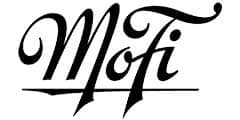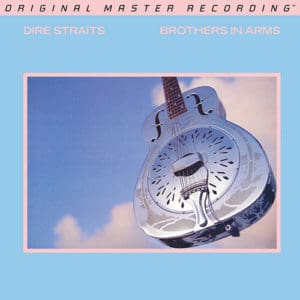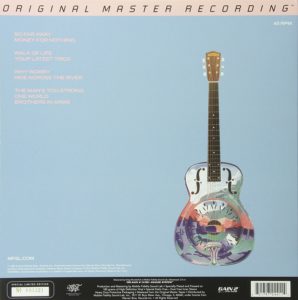Marketplace
2014 Mobile-Fidelity Sound Lab PRESSING
- Catalog Number MFSL 2-441
- Release Year 2014
- Vinyl Mastering Engineer Krieg Wunderlich
- Pressing Weight 180g
- # of Disks 2
- Jacket Style Gatefold
- Speed 45 RPM
When listening to this album I think of this band or music:
J. J. Cale, down to this record’s cover art (see Troubadour), but without the introspectiveness.
I would listen to this album while:
Polishing my 1937 National Style O Resonator guitar. (I wish!)
Music from this album would be a great soundtrack to:
What movie hasn’t used “Money for Nothing” in its soundtrack? OK, the song missed the cut for The Big Short, but would have fit right in.
Ear worms for all time, Dire Straits’ greatest hits (from Brothers in Arms and other albums) hold a plethora of sales records. The British band formed in 1977, back when its four original members were of an age when their contemporaries were more likely married and several years into a professional career rather than enjoying rock’s proverbial sex-and-drug lifestyle. Call Dire Straits, then, a more adult version of rock featuring fewer testosterone-driven lyrics yet still in possession of thrust-driven, upfront sound.
The group’s fifth studio album, Brothers in Arms, released in May 1985, took off on the charts like a rocket and stayed in the number-one position for weeks. The band had since expanded from its origins and included guest appearances by trumpeter Randy Brecker and, on two cuts, Sting. Everything about the work is big. Fittingly, it propelled Dire Straits to stadium-star status. The production surrounding Mark Knopfler’s guitar work, combined with sharp song craft, draws you back time and again.
Brothers in Arms was digitally recorded on a Sony 24-track digital tape machine. Nonetheless, the sound quality overcame its digital roots. The original LP features such good sound you’d be forgiven for never expecting it to be bettered. Mobile Fidelity’s reissue proves what once seemed too good to improve can now be enjoyed in undoubtedly superior quality. Yes, the bass is deeper and tighter. Yet, it’s not just the bass. The overall dynamic range sounds explosive on the Mobile Fidelity reissue.
On the original, there’s an obvious limit to how far you can turn up the volume before the digits grate on “Ride Across the River” or “Money for Nothing.” The 45RPM mastering dramatically opens up the range. More than with all but a few albums in my collection, this 2LP set delivers immense dynamics at high volume settings without collapsing into distortion.
More significantly, you’ll hear more texture and three-dimensionality up and down the spectrum, especially with the guitar sound. As pianist Steven Hough recently wrote in the New York Times, when he strikes a piano key, there is more to hear than that note alone—“the other strings vibrate with sympathetic overtones, forming a halo over every note.” The same principle applies to all instruments, and especially guitars. What’s often missing on older masterings—and most of the time with digital media—is an accurate reproduction of these sympathetic overtones. This trait is apparent throughout this pressing but nowhere more obvious than with the lush six-string sound on “So Far Away.”
Sure, you can tell the recording has digital roots, but the Mobile Fidelity kills the original vinyl sound when it comes to uncovering overtones, textures, and dimensionality. Once you hear the Mobile Fidelity 2LP set, you can’t go back.
Brothers in Arms



 5
5